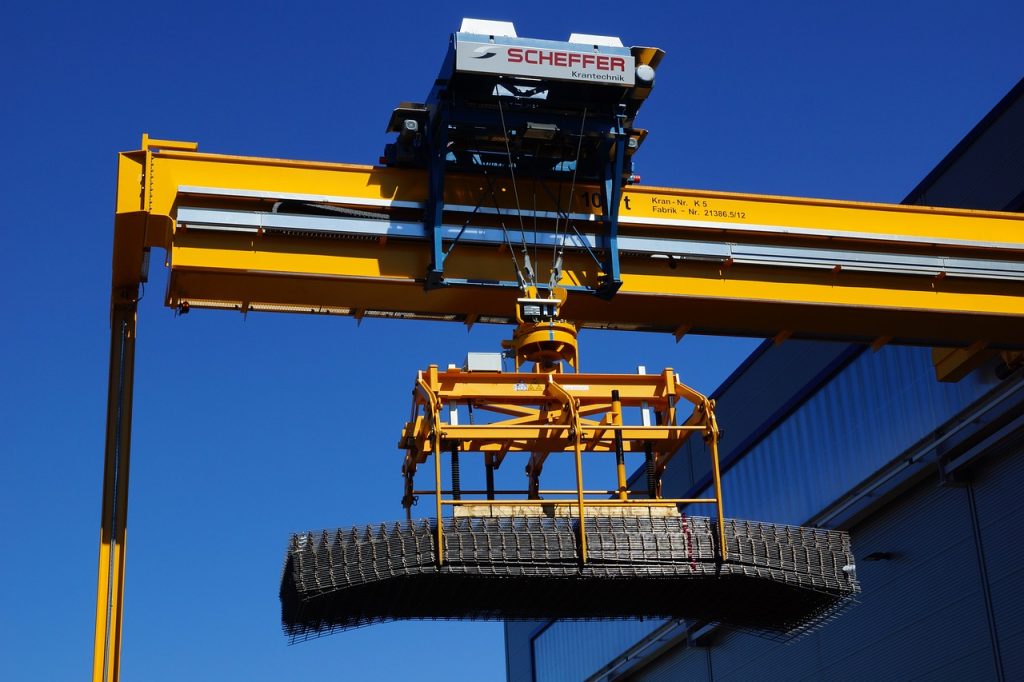Understanding the Key Differences Between Overhead Crane and Hoist Crane
Date: 2024-07-02 Share:
Cranes are essential devices used in various industries to lift, move, and lower heavy materials with precision and efficiency. They play a crucial role in construction sites, manufacturing plants, warehouses, and ports by facilitating the transportation of goods within confined spaces. Unlike standard lifting equipment, cranes are engineered to handle loads that may be physically unobtainable for traditional machinery. This makes them pivotal in projects where heavy lifting is inevitable, enhancing productivity while ensuring safety.
The industrial importance of cranes cannot be overstated. In manufacturing, for instance, cranes expedite the assembly process by moving heavy parts quickly and safely. Construction sites rely on cranes to position building materials like steel beams into place, significantly accelerating the pace of projects. Even in shipyards, cranes load and unload cargo, streamlining operations and cutting down on manual labor costs. Essentially, cranes serve as indispensable tools that boost operational efficiency, reduce workforce fatigue, and minimize the risk of accidents.
Breaking Down the Overhead Crane
Description of Overhead Crane
An overhead crane, sometimes referred to as a bridge crane, is a type of crane that consists of parallel runways with a traveling bridge spanning the gap. This configuration allows the crane to move both longitudinally and laterally, thus providing a larger area of coverage. Overhead cranes are commonly used in indoor environments such as factories or warehouses where goods need to be moved across high bay or span areas.
As one of the famous brands in the production of winches, cranes and crane parts, Nante Crane is dedicated to research and development of lifting and material handling technologies. We adopt innovative ideas and design in developing new products and services. Backed up by a wealth of industrial experience, we can provide customers with high quality lifting equipment and components.
Key Components of Overhead Cranes
Bridge
The bridge is a fundamental component of an overhead crane. It spans the width of the crane’s operating area and supports the trolley and hoist mechanism. Often constructed from sturdy steel or aluminum, the bridge ensures that the lifting system can move horizontally across the work area. It is designed to withstand significant loads, providing the structural backbone for the entire crane system.
Trolley
The trolley travels along the bridge and houses the hoist. This component is crucial for the lateral movement of the load. Trolleys are typically equipped with wheels or rollers that allow smooth and controlled movement. Depending on the application, trolleys can be manually operated, electronically powered, or even motorized for enhanced precision and speed. The robust design of trolleys ensures they can handle frequent use under heavy loads without compromising safety or efficiency.
Hoist
The hoist is the lifting mechanism and arguably the most critical part of the overhead crane. It consists of a drum or lift-wheel, around which a rope or chain is wound. The hoist lifts and lowers the load, operating either electrically, pneumatically, or manually. The strength, reliability, and capacity of the hoist dictate the overall lifting power of the crane. Sophisticated types of hoists come with additional safety features such as load limiters and anti-drop mechanisms to ensure secure lifting operations.
Applications of Overhead Cranes
Overhead cranes are versatile in their applications due to their ability to cover a large area within an industrial setting. They are predominantly used in manufacturing plants for the assembly of heavy machinery, where precise and repetitive lifting is required. Another significant application is in warehouses, where overhead cranes facilitate the efficient movement and storage of goods, reducing the need for human labor and the risk of injury. In shipyards and ports, overhead cranes are crucial for loading and unloading cargo from ships, thereby improving the efficiency of maritime operations. Additionally, in heavy engineering and fabrication industries, these cranes are used to handle exceptionally heavy components that would be impossible to move manually.
As one of the famous crane production and manufacturing brands, Nante Crane is committed to helping our clients reduce investment cost, improve production efficiency, and economize energy consumption. Nante Crane’s main products include industrial cranes, offshore cranes, Launching Crane, electric hoists, crane travel unit, mobile power supply system etc. with reliable and excellent performance.
Exploring the Hoist Crane
Description of Hoist Crane
A hoist crane, often simply called a hoist, is a simple yet powerful device specifically designed for lifting and lowering loads. Unlike overhead cranes, hoist cranes are more compact and usually employed for vertical movement in smaller controlled areas. They are often used either as standalone units or integrated into larger crane systems, like gantry cranes or jib cranes. The compact nature and versatility of hoist cranes make them suitable for a variety of lifting tasks, from small workshops to large-scale industrial operations.
Key Components of Hoist Cranes
Drum and Rope Mechanism
The drum and rope mechanism is at the core of the hoist crane’s lifting capability. The drum is a cylindrical component around which the rope or cable is wound. When the drum rotates, the length of the rope changes, enabling the lifting or lowering of the load. The rope is usually made of high-strength steel to handle substantial weights without breaking. The precision and control provided by the drum and rope mechanism are essential for accurate lifting tasks, ensuring that loads are moved smoothly and safely.
Hook and Lifting Medium
The hook and lifting medium are crucial for engaging with and securing the load. The hook is attached to the end of the rope and is usually made from forged steel for added strength and reliability. Depending on the application, the lifting medium can vary, including chains, wire ropes, or synthetic webbing. The design of the hook ensures that it can hook onto or around various load types securely. Advanced hooks may also come with locking mechanisms to prevent accidental disengagement during operations, thus adding a layer of safety.
Applications of Hoist Cranes
Hoist cranes are remarkably adaptable and find use in numerous industries. In smaller workshops, they are indispensable for lifting heavy tools and machinery parts, providing a safe and efficient way to manage loads. In manufacturing plants, hoist cranes are often used for repetitive lifting tasks, such as moving components along assembly lines. They are also vital in warehouses for stacking heavy goods, offering a compact solution where space is a premium. Additionally, hoist cranes are used in maintenance and repair operations, helping technicians lift heavy parts or equipment, thereby improving their work efficiency and reducing the likelihood of workplace injuries.
In addition to producing and manufacturing cranes, Nante Crane has achieved breakthroughs in core technology and has the ability to manufacture core components, which are widely used in more than 20 professional fields such as advanced manufacturing, metal processing, aerospace, etc. Nante Crane is committed to the research and development and manufacturing of handling machinery and technology.
Comparative Analysis: Overhead Crane vs. Hoist Crane
Structural Differences
The primary structural difference between overhead cranes and hoist cranes lies in their design and complexity. Overhead cranes feature a combination of bridges, trolleys, and hoists operating on parallel runways, enabling extensive horizontal and vertical movement. In contrast, hoist cranes are more compact and less complex, designed primarily for vertical lifting. While overhead cranes can cover significant areas and move loads in multiple directions, hoist cranes are mostly stationary and operate within a limited space.
Functional Differences
Functionally, overhead cranes offer more versatility and can handle larger and heavier loads due to their robust and expansive structure. They are ideal for applications requiring complex load handling over wide areas. Hoist cranes, however, are designed for straightforward lifting tasks, mainly focusing on vertical movement. They are often more affordable and easier to maintain but lack the extensive reach and load capacity of overhead cranes.
Usage Scenarios
Overhead cranes are best suited for large-scale industrial environments where extensive movement of heavy loads is required, such as in manufacturing plants, warehouses, and shipyards. Their ability to cover large areas and manage complex lifting scenarios makes them indispensable in such settings. Hoist cranes, on the other hand, are more appropriate for smaller, controlled environments requiring vertical lifting. They excel in workshops, smaller manufacturing units, and maintenance facilities where compact, precise lifting mechanisms are necessary.
Factors to Consider When Choosing Between Overhead Crane and Hoist Crane
When deciding whether to opt for an overhead crane or a hoist crane, several factors should be considered. First, evaluate the nature and scale of the lifting tasks. Overhead cranes are ideal for heavy, complex, and large-area operations, while hoist cranes are better for simpler, vertical lifting tasks in confined spaces. Second, consider the installation and maintenance costs. Overhead cranes are generally more expensive to install and maintain due to their complexity and size. Third, assess the specific requirements of your operations, such as load capacity and frequency of use. Finally, consider safety features and ease of use, as both types of cranes offer various options tailored to different operational needs.
Summary
In summary, understanding the key differences between overhead cranes and hoist cranes is crucial for selecting the right equipment for your industrial needs. Overhead cranes offer extensive functionality and load capacity suitable for large-scale operations, while hoist cranes provide compact, efficient, and cost-effective solutions for simpler lifting tasks. By carefully considering the structural and functional distinctions, as well as the specific requirements of your operations, you can make an informed decision that enhances productivity, safety, and efficiency in your workplace.




